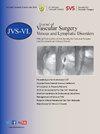Single-center clinical experience of cyanoacrylate embolization method for incompetent perforating veins in treating CEAP-6 patients
IF 2.8
2区 医学
Q2 PERIPHERAL VASCULAR DISEASE
Journal of vascular surgery. Venous and lymphatic disorders
Pub Date : 2024-07-01
DOI:10.1016/j.jvsv.2024.101939
引用次数: 0
Abstract
Objective
The most severe form of chronic venous insufficiency includes venous leg ulcers in the CEAP-6 stage. The aim of this study is to evaluate the relationship between incompetent perforator veins occluding with cyanoacrylate and closure of perforator veins and healing of venous leg ulcers in patients at the CEAP-6 stage.
Methods
A total of 187 patients who underwent cyanoacrylate application to incompetent perforator veins due to venous leg ulcers from 2018 to 2021 were retrospectively reviewed. Twelve months after the procedure, patients were evaluated for perforator vein closure, ulcer diameter, and Venous Clinical Severity Scale. Receiver operating characteristic analysis was used to estimate the probability of postoperative nonocclusion of the perforating vein based on the preoperative ulcers’ diameters and the perforating veins’ mean diameters. Univariate and multivariate binary logistic regression analyses were conducted to identify the risk factors associated with incomplete closure of the perforating vein.
Results
At the 12 months, 87.1% of patients experienced incompetent perforator veins closure, leading to complete healing of venous leg ulcers. Preoperative ulcer diameter significantly decreased from 7.20 ± 3.48 cm2 to 0.28 ± 0.77 cm2 after the procedure (P < .001). On average, 3.5 ± 1.01 perforating veins were treated, with a diameter of 4.09 ± 0.41 mm. No postoperative paresthesia or deep vein thrombosis occurred. Preoperative Venous Clinical Severity Scale scores decreased significantly from 17.85 ± 3.06 to 8.03 ± 3.53 postoperatively (P < .001). Patients with nonoccluded perforating veins had larger preoperative ulcer diameters (13.77 ± 1.78 cm2) than those with occluded perforating veins (6.24 ± 2.47 cm2; P < .001). The mean perforating vein diameter was also larger in nonoccluded perforating veins patients (4.45 ± 0.41 mm) than in occluded perforating veins patients (4.04 ± 0.38 mm; P < .001). The sensitivity, specificity, and accuracy of the preoperative ulcer diameter cutoff point of 11.25 cm2 for the possibility of postoperative nonocclusion of perforating veins were 100% each. In contrast, those for the preoperative mean perforating vein diameter cutoff point of 4.15 mm were determined as 66.7%, 79.1%, and 77.5%, respectively. The presence of diabetes mellitus increased the likelihood of incompetent perforator veins, remaining open by 3.4 times (95% confidence interval: 1.11-10.44; P = .032), whereas a 1 mm larger mean perforating vein diameter increased this likelihood by 9.36 times (95% confidence interval: 3.47-25.29; P < .001).
Conclusions
This study demonstrates that occlusion of incompetent perforator veins with cyanoacrylate is effective, safe, and associated with low complication rates in CEAP-6 patients. The findings support that cyanoacrylate occlusion of perforator veins may be a valuable option in the treatment of venous leg ulcers.
在治疗 CEAP-6 患者时采用氰基丙烯酸酯栓塞法治疗闭塞性静脉穿孔的单中心临床经验。
目的:慢性静脉功能不全的最严重形式包括 CEAP-6 阶段的腿部静脉溃疡。本研究的目的是评估使用氰基丙烯酸酯堵塞无功能穿孔静脉与CEAP-6期患者穿孔静脉闭合和腿部静脉溃疡愈合之间的关系:对2018年至2021年期间因静脉性腿部溃疡而接受氰基丙烯酸酯应用于无功能穿孔静脉的187例患者进行回顾性回顾。术后 12 个月,对患者的穿孔静脉闭合情况、溃疡直径和静脉临床严重程度量表进行评估。根据术前溃疡的直径和穿孔静脉的平均直径,采用受试者操作特征分析来估计术后穿孔静脉未闭合的概率。进行了单变量和多变量二元逻辑回归分析,以确定与穿孔静脉未完全闭合相关的风险因素:12个月后,87.1%的患者穿孔静脉闭合不全,导致腿部静脉溃疡完全愈合。与穿孔静脉闭塞的患者(6.24±2.47 cm2)相比,术前溃疡直径从 7.20±3.48 cm2 明显降低到术后(P2)的 0.28±0.77 cm2(术后穿孔静脉未闭塞的可能性 P2 为 100%)。相比之下,术前穿孔静脉平均直径临界点为 4.15 毫米的 P2 分别为 66.7%、79.1% 和 77.5%。糖尿病会使无功能穿孔静脉保持开放的可能性增加 3.4 倍(95% CI:1.11-10.44)(P = 0.032),而穿孔静脉平均直径增大 1 毫米会使这一可能性增加 9.36 倍(95% CI:3.47-25.29)(结论:糖尿病会使无功能穿孔静脉保持开放的可能性增加 3.4 倍(95% CI:1.11-10.44),而穿孔静脉平均直径增大 1 毫米会使这一可能性增加 9.36 倍(95% CI:3.47-25.29):本研究表明,使用氰基丙烯酸酯闭塞无功能穿孔静脉对 CEAP-6 患者有效、安全且并发症发生率低。研究结果表明,用氰基丙烯酸酯堵塞穿孔静脉可能是治疗静脉性腿部溃疡的一种有价值的选择。
本文章由计算机程序翻译,如有差异,请以英文原文为准。
求助全文
约1分钟内获得全文
求助全文
来源期刊

Journal of vascular surgery. Venous and lymphatic disorders
SURGERYPERIPHERAL VASCULAR DISEASE&n-PERIPHERAL VASCULAR DISEASE
CiteScore
6.30
自引率
18.80%
发文量
328
审稿时长
71 days
期刊介绍:
Journal of Vascular Surgery: Venous and Lymphatic Disorders is one of a series of specialist journals launched by the Journal of Vascular Surgery. It aims to be the premier international Journal of medical, endovascular and surgical management of venous and lymphatic disorders. It publishes high quality clinical, research, case reports, techniques, and practice manuscripts related to all aspects of venous and lymphatic disorders, including malformations and wound care, with an emphasis on the practicing clinician. The journal seeks to provide novel and timely information to vascular surgeons, interventionalists, phlebologists, wound care specialists, and allied health professionals who treat patients presenting with vascular and lymphatic disorders. As the official publication of The Society for Vascular Surgery and the American Venous Forum, the Journal will publish, after peer review, selected papers presented at the annual meeting of these organizations and affiliated vascular societies, as well as original articles from members and non-members.
 求助内容:
求助内容: 应助结果提醒方式:
应助结果提醒方式:


